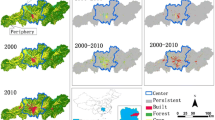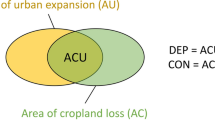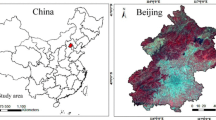Abstract
Over the past few decades, built-up land in China has increasingly expanded with rapid urbanization, industrialization and rural settlements construction. The expansions encroached upon a large amount of cropland, placing great challenges on national food security. Although the impacts of urban expansion on cropland have been intensively illustrated, few attentions have been paid to differentiating the effects of growing urban areas, rural settlements, and industrial/transportation land. To fill this gap and offer comprehensive implications on framing policies for cropland protection, this study investigates and compares the spatio- temporal patterns of cropland conversion to urban areas, rural settlements, and industrial/ transportation land from 1987 to 2010, based on land use maps interpreted from remote sensing imagery. Five indicators were developed to analyze the impacts of built-up land expansion on cropland in China. We find that 42,822 km2 of cropland were converted into built-up land in China, accounting for 43.8% of total cropland loss during 1987–2010. Urban growth showed a greater impact on cropland loss than the expansion of rural settlements and the expansion of industrial/transportation land after 2000. The contribution of rural settlement expansion decreased; however, rural settlement saw the highest percentage of traditional cropland loss which is generally in high quality. The contribution of industrial/transportation land expansion increased dramatically and was mainly distributed in major food production regions. These changes were closely related to the economic restructuring, urban-rural transformation and government policies in China. Future cropland conservation should focus on not only finding a reasonable urbanization mode, but also solving the “hollowing village” problem and balancing the industrial transformations.
Similar content being viewed by others
References
Anderson K, Peng C Y, 1998. Feeding and fueling China in the 21st century. World Development, 26(8): 1413–1429.
Boland A, 2000. Feeding fears: Competing discourses of interdependency, sovereignty, and China’s food security. Political Geography, 19: 55–76.
Cai Y L, Fu Z Q, Dai E F, 2002. The minimum areas per capita of cultivated land and its implication for the optimization of land resources allocation. Acta Geographica Sinica, 57(2): 127–134. (in Chinese)
d’Amour C B, Reitsma F, Baiocchi G et al., 2017. Future urban land expansion and implications for global croplands. Proceedings of the National Academy of Sciences, 114(34): 8939–8944.
Deng X, Huang J, Rozelle S et al., 2006. Cultivated land conversion and potential agricultural productivity in China. Land Use Policy, 23(4): 372–384.
Deng X, Huang J, Rozelle S et al., 2015. Impact of urbanization on cultivated land changes in China. Land Use Policy, 45: 1–7.
Ding C, 2003. Land policy reform in China: Assessment and prospects. Land Use Policy, 20: 109–120.
Jiang X C, 2003. Urbanization in China on WTO backgrounds. Urban Studies, 10(5): 23–34. (in Chinese)
Jiao J, Wang J, ** F et al., 2016. Understanding relationship between accessibility and economic growth: A case study from China (1990–2010). Chinese Geographical Science, 26(6): 803–816.
Li G, Fang C, Qiu D et al., 2014. Impact of farmer households’ livelihood assets on their options of economic compensation patterns for cultivated land protection. Journal of Geographical Sciences, 24(2): 331–348.
Li Y, Li Y, Westlund H et al., 2015. Urban–rural transformation in relation to cultivated land conversion in China: Implications for optimizing land use and balanced regional development. Land Use Policy, 47: 218–224.
Liu J, Liu M, Tian H et al., 2005. Spatial and temporal patterns of China’s cropland during 1990–2000. An analysis based on Landsat TM data. Remote Sensing of Environment, 98(4): 442–456.
Liu L, Xu X, Liu J et al., 2015. Impact of farmland changes on production potential in China during 1990–2010. Journal of Geographical Sciences, 25(1): 19–34.
Liu Y S, Wang J Y, Long H L, 2010. Analysis of arable land loss and its impact on rural sustainability in southern Jiangsu Province of China. Journal of Environmental Management, 91(3): 646–653.
Long H, Liu Y, Wu X et al., 2009. Spatio–temporal dynamic patterns of farmland and rural settlements in Su–**–Chang region: Implications for building a new countryside in coastal China. Land Use Policy, 26(2): 322–333.
Longley P A, 2002. Geography: Will development in urban remote sensing and GIS lead to better urban geography? Progress in Human Geography, 26(2): 231–239.
Ministry of Construction of China (MCC), 1993. Village/Small–Town Planning Standards (GB 50188–93). Bei**g: Ministry of Construction of P. R. China. (in Chinese)
National Bureau of Statistics of China (NBSC), 2011. China Statistical Yearbook. Bei**g: China Statistics Press. (in Chinese)
Nationwide Committee of Agricultural Regionalization (NCAR), 1981. The Comprehensive Agricultural Regionalization of China. Bei**g: Agriculture Press. (in Chinese)
Pacione M, 2001. The internal structure of cities in the third world. Geography, 86(3): 189–209.
Pandey B, Seto K C, 2015. Urbanization and agricultural land loss in India: Comparing satellite estimates with census data. Journal of Environmental Management, 148: 53–66.
Qin H, 2010. Rural–to–urban labor migration, household livelihoods, and the rural environment in Chongqing Municipality, Southwest China. Human Ecology, 38(5): 675–690.
She L M, **e B G, 2000. Some considerations about the dynamic balance of the total cultivated land quantity in China. Research of Agricultural Modernization, 21(2): 87–90. (in Chinese)
Seto K C, Fragkias M, Güneralp B et al., 2011. A meta–analysis of global urban land expansion. PLoS One, 6(8): e23777.
Tan M, Li X, **e H et al., 2005. Urban land expansion and arable land loss in China: A case study of Bei**g–Tian**–Hebei region. Land Use Policy, 22(3): 187–196.
Tania D M, Lopez T, Aide M et al., 2001. Urban expansion and the losses of prime agricultural lands in Putero Rico. Ambio, 30: 49–54.
Tu S, Long H, 2017. Rural restructuring in China: Theory, approaches and research prospect. Journal of Geographical Sciences, 27(10): 1169–1184.
Wang Y, Scott S, 2008. Illegal farmland conversion in China’s urban periphery: Local regime and national transitions. Urban Geography, 29(4): 327–347.
**e J, ** X, Lin Y et al., 2017. Quantitative estimation and spatial reconstruction of urban and rural construction land in Jiangsu Province, 1820–1985. Journal of Geographical Sciences, 27(10): 1185–1208.
Yang H, Li X B, 2000. Cultivated land and food supply in China. Land Use Policy, 17: 73–88.
Yeh A G O, Li X, 1999. Economic development and agricultural land loss in the Pearl River Delta, China. Habitat International, 23(3): 373–390.
Zhang Z, Wang X, Zhao X et al., 2014. A 2010 update of national land use/cover database of China at 1:100000 scale using medium spatial resolution satellite images. Remote Sensing of Environment, 149: 142–154.
Zuo L, Zhang Z, Zhao X et al., 2014. Multitemporal analysis of cropland transition in a climate–sensitive area: A case study of the arid and semiarid region of northwest China. Regional Environmental Change, 14(1): 75–89.
Acknowledgements
All the authors are grateful to Professor Keith. C. Clarke for his valuable comments on an earlier version of the paper. The comments from the reviewers have been greatly helpful for strengthening the arguments of the paper.
Author information
Authors and Affiliations
Corresponding author
Additional information
Foundation: National Major Science and Technology Program for Water Pollution Control and Treatment, No.2017ZX07101001
Rights and permissions
About this article
Cite this article
Ju, H., Zhang, Z., Zhao, X. et al. The changing patterns of cropland conversion to built-up land in China from 1987 to 2010. J. Geogr. Sci. 28, 1595–1610 (2018). https://doi.org/10.1007/s11442-018-1531-8
Received:
Accepted:
Published:
Issue Date:
DOI: https://doi.org/10.1007/s11442-018-1531-8




